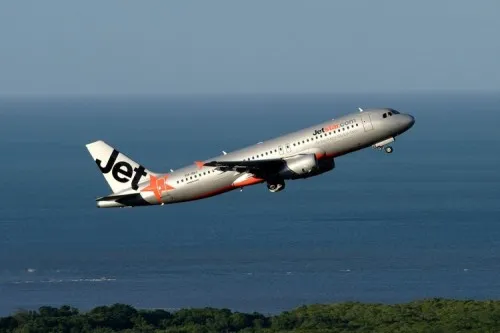
Maintenance error leaves Jetstar plane without thrust reversers
Mar 22, 2019

A Jetstar aircraft faced a significant maintenance oversight when technicians inadvertently left the thrust reversers inoperative after a scheduled check. This critical error went unnoticed during pre-flight inspections, raising concerns about operational safety. The thrust reversers are essential for slowing down the aircraft upon landing, and their absence can lead to longer landing distances and increased reliance on brakes. Fortunately, the issue was identified before any flights occurred, preventing potential incidents. This incident highlights the importance of thorough maintenance protocols and routine checks in aviation to ensure passenger safety and aircraft reliability.
In a recent incident involving Jetstar Airways, a maintenance error led to a serious safety concern when a plane was found to be operating without its thrust reversers. This critical component is essential for reducing the aircraft's speed upon landing, and the absence of it can lead to dangerous situations. In this article, we will explore the implications of this maintenance oversight, the importance of thrust reversers, and the measures that can prevent such errors in the future.
Understanding Thrust Reversers
Thrust reversers are devices that help in decelerating an aircraft after touchdown. Once the airplane lands, these systems redirect engine thrust forward, rather than backward, which assists in slowing down the plane efficiently. The functionality of thrust reversers is vital for maintaining safe landing distances, especially on shorter runways or in adverse weather conditions. Without them, an aircraft may require a significantly longer distance to come to a complete stop, which can endanger passengers and crew.
Impact of Maintenance Errors
Maintenance errors in the aviation industry can have severe consequences. In the case of the Jetstar incident, the failure to check the thrust reversers during routine maintenance was a significant oversight. Such errors can stem from a variety of factors, including:
- Lack of proper training for maintenance personnel
- Inadequate maintenance protocols
- Poor communication between maintenance teams
- Insufficient oversight and auditing of maintenance practices
The consequences of neglecting these factors can lead to operational disruptions and safety risks. In this instance, the Jetstar aircraft faced potential challenges during landing, which could have resulted in longer stopping distances and increased risk of runway excursions.
Importance of Proper Maintenance Procedures
To prevent such maintenance errors, airlines must implement robust maintenance procedures and protocols. Here are some essential practices that can help enhance safety:
| Practice | Description |
|---|---|
| Regular Training | Ensure that all maintenance staff receive ongoing training and certification to stay updated on the latest safety protocols and equipment. |
| Routine Audits | Conduct regular audits of maintenance practices to identify areas for improvement and ensure compliance with safety regulations. |
| Clear Communication | Establish effective lines of communication between maintenance teams and flight crews to ensure that all necessary checks are performed. |
| Checklists | Utilize detailed checklists for maintenance procedures, ensuring that all critical components, such as thrust reversers, are inspected and verified. |
Regulatory Oversight
Regulatory bodies, such as the Federal Aviation Administration (FAA) in the United States and the European Union Aviation Safety Agency (EASA), play a crucial role in setting maintenance standards for airlines. These organizations establish regulations that airlines must follow to ensure the safety and reliability of their operations. Compliance with these regulations is essential to prevent maintenance errors like the one experienced by Jetstar.
In addition to regulatory oversight, airlines should also foster a safety culture that prioritizes reporting and addressing maintenance issues without fear of reprisal. This proactive approach encourages employees to speak up about potential safety concerns, ultimately leading to improved maintenance practices and safer flights.
Lessons Learned from the Jetstar Incident
The Jetstar maintenance error serves as a reminder of the importance of diligence in aviation maintenance. Airlines must learn from such incidents to enhance safety measures and protocols. Key takeaways include:
- The necessity of thorough inspections of critical components during maintenance
- The importance of training and educating maintenance personnel on the significance of each component
- The value of a safety-first culture that encourages communication and transparency
Conclusion
Maintenance errors can have far-reaching implications in the aviation industry, as highlighted by the Jetstar incident involving the thrust reversers. By implementing rigorous maintenance protocols, fostering a culture of safety, and adhering to regulatory guidelines, airlines can significantly reduce the risk of such errors occurring in the future. It is crucial for all stakeholders in the aviation industry to prioritize maintenance excellence to ensure the safety and well-being of passengers and crew. Only through collective effort can we enhance the reliability of air travel and prevent incidents like these from happening again.
Related Articles

Explore Thailand: The Best Islands to Visit for Paradise, Adventure, and Relaxation

The Ultimate Guide to the Best Islands in Thailand for Your Next Getaway

Do babies need passports? How to get a passport for a newborn

How to get a U.S. passport fast: here’s how to expedite the process

What is Mobile Passport Control: 5 reasons why you should use it

SENTRI vs. Global Entry: A detailed guide

Do you need a passport to go to the Bahamas? Let’s find out

Do you need a passport to go to Mexico? A detailed guide

Do you need a passport to go to Canada? We got the answer

Do You Need a Passport for a Cruise: An Essential Travel Guide

Booster Seat Requirements: All the Rules to Follow in Your Rental Car

What Are the World’s Most Powerful Passports, and How Does Yours Rank?

How to Take a Passport Photo at Home: A Helpful Guide

You've got to have heart! Southwest's new livery

Your opinion: Should water be free on low cost carriers?

Young women bolder than guys as solo travellers
